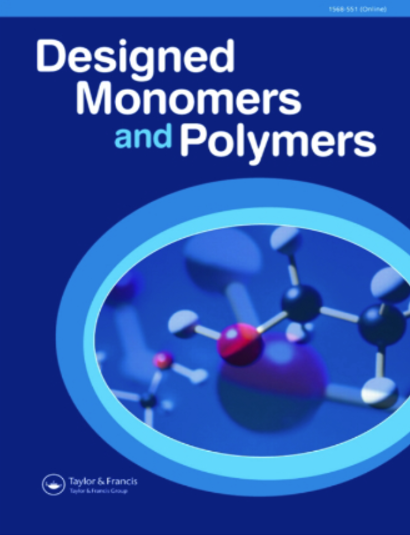原位反应增强聚羟基丁酸酯-羟基戊酸酯的热稳定性
IF 1.8
4区 化学
Q3 POLYMER SCIENCE
引用次数: 4
摘要
摘要聚羟基丁酸酯-共羟基戊酸酯(PHBV)由于其可再生性、良好的机械性能和阻隔性能以及海洋生物降解性,近年来受到越来越多的关注。然而,加工过程中的严重热降解是一个主要缺点,并限制了其应用。在这项工作中,通过加入反应剂,研究了PHBV在熔融加工过程中的热稳定性。使用不同含量的过氧化异丙基二(叔丁基)苯(DB)、异氰脲酸酯三烯丙基酯(TAIC)和多功能环氧扩链剂(ECE)。研究了混合转矩、机械性能和热性能。结果表明,PHBV的混合转矩在10分钟的熔融时间内逐渐降低,最终降至2 N.m。加入ECE后,混合转矩略有增加,但在10分钟内仍有所下降。对于由DB/TAIC或DB/TAIC/ECE组成的系统,混合转矩达到平衡,并且它们的值比单独的PHBV高大约两倍。当添加高含量的DB和TAIC时,主要观察到可能的交联反应和扭矩逆转。1H NMR谱表明DB/TAIC与PHBV反应。由0.3份的DB、0.1份的TAIC和0.5份的ECE组成的体系的杨氏模量和拉伸强度分别从1440和40.4MPa提高到1803和55.5MPa。TGA热谱图显示,添加DB/TAIC和ECE可改善起始温度和拐点。研究结果表明,DB/TAIC和ECE的结合是在不牺牲力学性能的情况下提高熔体粘度的最简单有效的方法之一。本文章由计算机程序翻译,如有差异,请以英文原文为准。
Thermal stability enhancement of poly(hydroxybutyrate-co-hydroxyvalerate) through in situ reaction
ABSTRACT Poly(hydroxybutyrate-co-hydroxyvalerate) (PHBV) has recently caught more and more attention due to its renewability, good mechanical and barrier properties, as well as marine biodegradability. However, the severe thermal degradation during processing is a major drawback and limits its application. In this work, the thermal stability of PHBV during melt-processing was investigated by incorporating reactive agents. Various contents of Di(tert-butylperoxyisopropyl)benzene (DB), Triallyl isocyanurate (TAIC) and multi-functional epoxy chain extender (ECE) were used. The mixing torque, mechanical and thermal properties were studied. The results revealed that the mixing torque of PHBV gradually decreased during 10 min of melting time and eventually dropped to 2 N.m. Upon adding ECE, the mixing torque slightly increased but still decreased during 10 min period. For the system consisting of DB/TAIC or DB/TAIC/ECE, the mixing torque reached the equilibrium and their values were roughly twofold higher than PHBV alone. The possible crosslinking reaction and torque reversion were predominantly observed when adding high contents of DB and TAIC. 1 H NMR spectra suggested the reaction of DB/TAIC and PHBV. Young’s modulus and tensile strength of system consisting of DB at 0.3 phr, TAIC at 0.1 phr and ECE at 0.5 phr increased from 1440 and 40.4 MPa to 1803 and 55.5 MPa, respectively. TGA thermograms showed that the onset temperature and inflection point were improved when adding DB/TAIC and ECE. From the findings, it indicated that the combination of DB/TAIC and ECE was one of the simplest and effective ways to improve the melt viscosity without sacrificing the mechanical properties.
求助全文
通过发布文献求助,成功后即可免费获取论文全文。
去求助
来源期刊

Designed Monomers and Polymers
化学-高分子科学
CiteScore
3.30
自引率
0.00%
发文量
28
审稿时长
2.1 months
期刊介绍:
Designed Monomers and Polymers ( DMP) publishes prompt peer-reviewed papers and short topical reviews on all areas of macromolecular design and applications. Emphasis is placed on the preparations of new monomers, including characterization and applications. Experiments should be presented in sufficient detail (including specific observations, precautionary notes, use of new materials, techniques, and their possible problems) that they could be reproduced by any researcher wishing to repeat the work.
The journal also includes macromolecular design of polymeric materials (such as polymeric biomaterials, biomedical polymers, etc.) with medical applications.
DMP provides an interface between organic and polymer chemistries and aims to bridge the gap between monomer synthesis and the design of new polymers. Submssions are invited in the areas including, but not limited to:
-macromolecular science, initiators, macroinitiators for macromolecular design
-kinetics, mechanism and modelling aspects of polymerization
-new methods of synthesis of known monomers
-new monomers (must show evidence for polymerization, e.g. polycondensation, sequential combination, oxidative coupling, radiation, plasma polymerization)
-functional prepolymers of various architectures such as hyperbranched polymers, telechelic polymers, macromonomers, or dendrimers
-new polymeric materials with biomedical applications
 求助内容:
求助内容: 应助结果提醒方式:
应助结果提醒方式:


